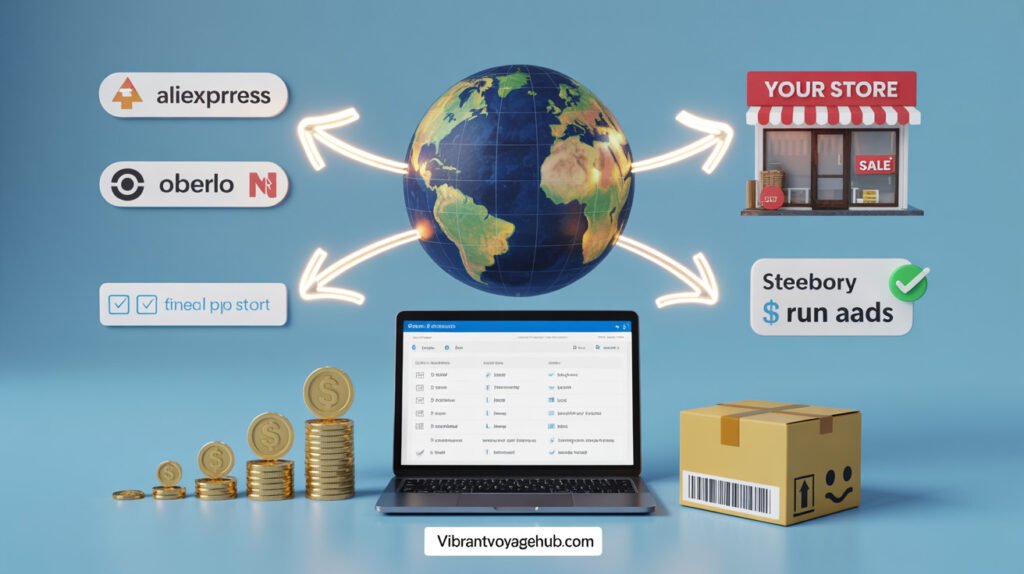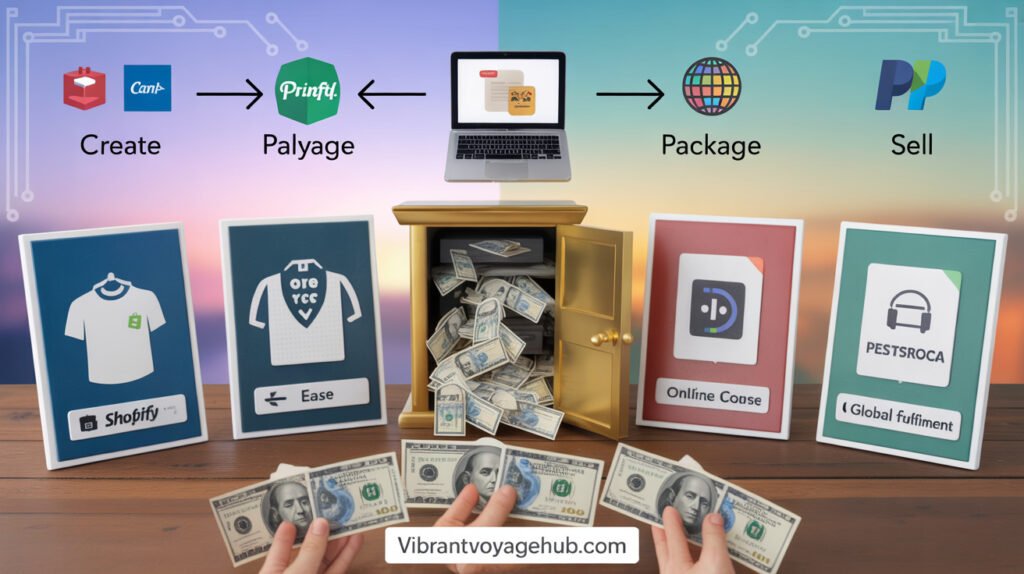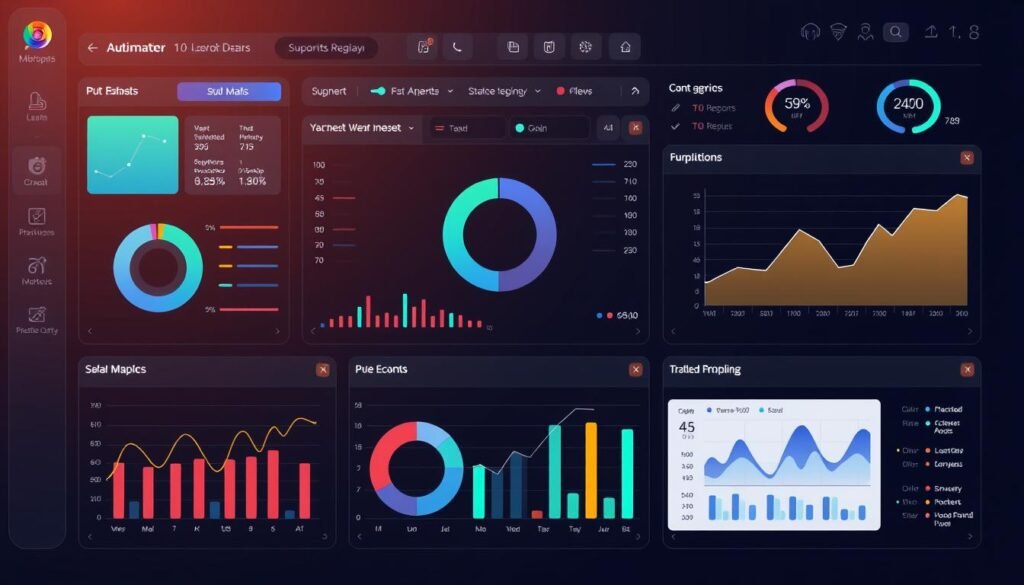Automate Your Income: 5 Online Businesses That Run on Autopilot
You’ve likely heard the promise: earn money while you sleep. For many, this sounds too good to be true. However, with the right business ideas, it’s entirely possible to create a steady stream of income that doesn’t require your constant presence.
The foundation of passive income lies in creating value that continues to generate revenue without being directly tied to your time. Modern entrepreneurs are leveraging automation to achieve this, setting up businesses that run on autopilot and yield consistent returns.
By understanding how to create and automate online businesses, you can break free from the constraints of trading time for money. The key is to identify viable business models that can be set up once and then continue to generate income with minimal ongoing effort.
Key Takeaways
- Understand how automation can create passive income streams.
- Learn about effective online business models that can be automated.
- Discover the importance of value creation in successful automated businesses.
- Gain insights into the initial work required to build autopilot businesses.
- Recognize the role of digital tools in revolutionizing passive income.
The Power of Passive Income in Today’s Digital Economy
As the digital economy continues to evolve, the power of passive income is becoming increasingly evident. You are now able to leverage digital technology to create income streams that aren’t directly tied to your time.
What Makes Income Truly Passive?
Truly passive income is earned without actively trading your time for money. It’s about creating a business that generates income with minimal ongoing effort. Successful entrepreneurs achieve this by selling digital products, assets, and programs, and leveraging existing systems to create income streams.
The Foundation of Value Creation
The foundation of passive income is value creation. To earn passive income, you must provide value in a way that isn’t directly tied to your time. This means creating digital products, offering services, or building a business that can operate with minimal intervention. By focusing on value creation, you can build a sustainable income stream that continues to generate money over time.
Understanding Business Automation for Financial Freedom
In today’s digital economy, business automation is key to unlocking true financial freedom. By leveraging digital tools to minimize manual work, you can build businesses that run smoothly without constant supervision. This enables you to focus on strategic growth and enjoy more free time.
Key Benefits of Automated Business Models
Automated business models offer several key benefits, including time efficiency, consistency in operations, and scalability. By automating repetitive tasks such as marketing, customer service, and order fulfillment, you can ensure reliable operations and easily expand your business. This allows you to allocate more time to strategic decisions and growth initiatives.
The automation of business processes not only enhances efficiency but also reduces the effort required to manage day-to-day operations. As a result, you can achieve a better work-life balance and increase your overall income.
Setting Realistic Expectations: Effort vs. Reward
While business automation can significantly reduce the work involved in managing a business, it’s essential to set realistic expectations about the initial effort required to set up automated systems. The long-term rewards of automation, including increased passive income and financial freedom, make the initial investment worthwhile.
By understanding the relationship between effort and reward in automated businesses, you can better plan your path to financial freedom. It’s crucial to design your business with systems thinking, ensuring that it can run with minimal intervention, allowing you to reap the benefits of autopilot business management.
Ecommerce Dropshipping: Your First Automated Business

Dropshipping is an attractive ecommerce business model that allows you to sell products without holding any inventory. This model simplifies the process of running an online store, as you don’t have to worry about storing or shipping products.
How Dropshipping Works
The dropshipping process is straightforward. When a customer places an order in your store, you forward the order and customer details to your supplier. The supplier then ships the products directly to the customer. This way, you can focus on marketing and sales without handling the logistics.
Setting Up Your Dropshipping Store
To set up a successful dropshipping store, you need to follow a few key steps. First, find a niche that interests you and has a demand in the market. Next, choose a reliable supplier who can provide quality products and efficient shipping. Platforms like AliExpress and Oberlo can connect you with trustworthy suppliers. Then, create your online store using a user-friendly platform like Shopify. Finally, implement marketing strategies to drive traffic to your store and increase sales.
Automation Tools for Dropshipping Success
To maximize the potential of your dropshipping business, you need to leverage automation tools. These tools can help streamline order processing, manage inventory levels, and improve customer communication. By automating repetitive tasks, you can save time and focus on growing your business and earning passive income. Some essential automation tools include software for order fulfillment, inventory management, and marketing automation.
By understanding how dropshipping works and utilizing the right tools and platforms, you can create a successful and automated ecommerce business. This model offers numerous benefits, including low startup costs, minimal overhead expenses, and the potential to earn passive income. With the right strategies and automation, you can scale your business and achieve financial freedom.
Print-on-Demand: Creative Passive Income

The rise of print-on-demand has opened up new avenues for entrepreneurs to earn passive income by selling custom merchandise without the need to hold inventory. This business model allows you to focus on design and marketing while a reliable print-on-demand service handles printing, packaging, and shipping.
The Print-on-Demand Business Model
The print-on-demand business model is based on producing items only after they’re purchased, eliminating the need for inventory management. This approach reduces financial risk and allows you to offer a wide range of products without worrying about storage space.
Getting Started with Print-on-Demand
To start a print-on-demand business, you need to choose a niche and partner with a reliable print-on-demand service like Printful or Printify. These platforms integrate with your online store, allowing you to upload your designs and start selling custom products.
Scaling Your Print-on-Demand Business
As your print-on-demand business grows, you can scale by expanding your product line, targeting new people, and optimizing your marketing strategies. With the right approach, you can increase sales and earn a steady passive income.
By leveraging the power of print-on-demand, you can create a successful online store that meets the demand for custom products in your chosen niche. With minimal upfront costs and automated fulfillment, print-on-demand is an attractive option for entrepreneurs looking to earn income online.
Digital Products: Create Once, Sell Forever

Creating digital products is a lucrative way to earn passive income online. Digital products require no inventory and no shipping, with minimal overhead costs. If you’re an expert in a niche, you can package your knowledge into an e-book or guide.
Types of Profitable Digital Products
Various types of digital products can be profitable, including ebooks, online courses, templates, software, and printables. For instance, if you have expertise in marketing, personal finance, or fitness, you can create an online course or e-book. Business owners love time-saving resources, such as Canva templates or financial planning spreadsheets.
The online education industry is growing rapidly, making it an ideal time to create and sell digital products. Platforms like Udemy, Teachable, and Skool make it easy to create and sell courses. You can also sell your digital products via Gumroad or your website.
Platforms for Selling Digital Products
Several platforms are designed specifically for selling digital products. Gumroad allows you to sell ebooks, software, and other digital goods directly to customers. Teachable and Skool are ideal for creating and selling online courses. You can also use Etsy to sell digital products like printables and templates.
Automating Your Digital Product Sales
To make your digital product sales passive, you can automate the delivery process using platforms like ThriveCart or SendOwl. These tools handle delivery, customer service, and payment processing, making it easy to sell digital products without constant intervention.
Setting up evergreen sales funnels can also help automate your sales process. By creating a sales funnel that brings in leads and converts them automatically, you can earn passive income from your digital products. Continuously updating and improving your digital products will help keep sales steady.
Online Courses: Monetize Your Knowledge

Online courses offer a scalable way to share your knowledge and earn passive income. With the rise of e-learning, creating and selling online courses has become a viable business model. You can monetize your expertise by transforming it into structured, valuable learning experiences for your audience.
The Growing Demand for Online Education
The online education market is experiencing explosive growth, driven by the increasing demand for specialized knowledge. People are seeking flexible, accessible ways to learn new skills, making online courses an attractive option. By creating high-quality content, you can tap into this growing demand and establish a profitable business.
Creating Your First Online Course
To create a successful online course, start by identifying your area of expertise and breaking down your topic into modules or lessons. Use a good quality camera and microphone to record your lessons. Platforms like Thinkific and Udemy make it easy to host and sell your courses. Once your content is ready, upload it to your chosen platform and launch your course.
Marketing and Selling Your Course on Autopilot
To sell your course on autopilot, leverage automated marketing systems, including email sequences, webinars, and social media campaigns. Pricing your course correctly is also crucial; it should reflect the value you offer while maximizing enrollment. By creating a course ecosystem with multiple offerings at different price points, you can maximize revenue and ensure long-term success.
By following these steps and utilizing the right tools and platforms, you can create a thriving online course business that generates significant passive income. Focus on creating high-quality content, engaging with your audience, and continually optimizing your marketing strategies to achieve success.
Affiliate Marketing: Earn Commissions Without Creating Products

Affiliate marketing allows you to earn passive income by promoting products you believe in. This evergreen business model enables you to start without expertise and scale your business as you grow. Essentially, you promote other companies’ products and earn commissions on resulting sales, making it a straightforward way to monetize your online presence.
Affiliate marketing creates a win-win situation for both you and the product creators. You benefit from promoting products that align with your audience’s interests, while the product creators gain increased exposure and sales. To succeed, focus on building trust with your audience by promoting high-quality products that add value to their lives.
How Affiliate Marketing Creates Passive Income
Affiliate marketing generates passive income through content that continues to attract audiences and produce commissions over time. By creating valuable content, such as blog posts, videos, or social media posts, you can drive organic traffic to your affiliate links. As your content ranks higher in search engines, you’ll earn more commissions without additional effort.
Choosing Profitable Affiliate Niches
Selecting the right niche is crucial for affiliate marketing success. Profitable niches include software and tools, online education, ecommerce, and physical products. When choosing a niche, consider your interests, audience needs, and the potential for monetization. Research high-demand products and analyze competitors to identify opportunities.
Automating Your Affiliate Marketing Business
To maximize your affiliate marketing income, automate your business processes. Write SEO-optimized blog posts that rank over time, review products in YouTube videos, and create email lists with automated sequences. You can also use social media scheduling tools to maintain a consistent presence. By automating these tasks, you’ll save time and increase your passive income potential.
To further optimize your affiliate marketing business, explore high-converting affiliate programs with generous commission structures. Some of the highest paying affiliate programs are in niches like software, online education, and financial services. By promoting these products and leveraging automation tools, you can significantly boost your earnings.
Automate Your Income: 5 Online Businesses That Run on Autopilot
Automating your income requires selecting the right online business model that aligns with your skills and goals. With various options available, it’s crucial to compare and contrast these models to make an informed decision.
Comparing the Five Business Models
The five automated business models discussed – ecommerce dropshipping, print-on-demand, digital products, online courses, and affiliate marketing – each have unique characteristics. To help you understand their differences, let’s examine them based on several key factors.
| Business Model | Startup Costs | Technical Requirements | Time Investment | Income Potential |
|---|---|---|---|---|
| Ecommerce Dropshipping | Low | Moderate | High | Medium |
| Print-on-Demand | Low | Low | Medium | Medium |
| Digital Products | Low | Moderate | High | High |
| Online Courses | Medium | High | High | High |
| Affiliate Marketing | Low | Low | Medium | Medium |
Choosing the Right Model for Your Skills and Goals
When selecting a business model, consider your skills, resources, and goals. For instance, if you have a talent for creating digital content, selling digital products or creating online courses might be the most suitable option. On the other hand, if you prefer marketing without holding inventory, affiliate marketing or ecommerce dropshipping could be more appealing.
By understanding the characteristics of each business model and aligning them with your strengths and objectives, you can make an informed decision and set yourself up for success in the world of automated online businesses.
Essential Tools for Business Automation

In today’s digital economy, leveraging the right automation tools can significantly boost your business productivity. To achieve successful automation, it’s crucial to understand the various categories of tools available and how they can be integrated into your operations.
Marketing Automation Tools
Marketing automation platforms handle email sequences, social media posting, and ad management, streamlining your marketing efforts. Tools like Sirge provide centralized insights from all your ads and traffic sources, helping you make data-driven decisions that boost your ROI.
Customer Service Automation
Customer service automation involves using chatbots, help desk software, and automated response systems to enhance customer experience. These tools help in providing 24/7 support, reducing response times, and improving customer satisfaction.
Financial and Administrative Automation
Financial automation solutions handle invoicing, payment processing, and accounting tasks, reducing manual labor and minimizing errors. Administrative automation tools assist in scheduling, project management, and team coordination, ensuring smooth business operations.
By embracing these AI-powered automation tools, you can unlock explosive growth potential for your business. Whether it’s through targeted marketing campaigns or personalized customer engagement, the right tools help you stay ahead of the curve.
Building Systems That Scale Without Your Constant Input
As you build your online business, creating systems that can scale without your constant input is crucial for long-term success. This involves developing documented processes that enable consistent operations without constant oversight, allowing you to focus on growth and strategy rather than day-to-day management.
Creating Standard Operating Procedures
To create scalable systems, you need to develop comprehensive standard operating procedures (SOPs) that anyone can follow. This involves identifying key business processes that can be systematized for scalability and documenting them in a clear, step-by-step manner. By doing so, you can ensure that your business operations are consistent and reliable, even when you’re not directly involved.
Effective SOPs also help in documenting business knowledge, preventing operational bottlenecks tied to specific individuals. This makes it easier to train new team members and ensures that your business can continue to operate smoothly even if someone leaves.
Outsourcing vs. Automation: Finding the Right Balance
When building scalable systems, it’s essential to determine whether tasks are better suited for automation or outsourcing. Automation is ideal for repetitive, rule-based tasks that don’t require human judgment, while outsourcing is better for tasks that require specialized skills or human interaction. By finding the right balance between automation and outsourcing, you can maximize efficiency and minimize costs.
| Task Type | Automation | Outsourcing |
|---|---|---|
| Repetitive, rule-based tasks | Yes | No |
| Tasks requiring human judgment | No | Yes |
| Tasks requiring specialized skills | No | Yes |

Common Pitfalls to Avoid When Automating Your Business
To ensure the long-term success of your automated business, it’s essential to steer clear of certain common pitfalls. While automation can streamline operations and increase efficiency, it can also introduce new challenges if not implemented carefully.
Over-Automation: When Human Touch Matters
One of the most significant risks of automation is over-automation, particularly in areas where human interaction creates value for customers. While automating routine tasks can free up time for more strategic activities, relying too heavily on automation can lead to a loss of personal touch, potentially harming customer service and overall business reputation.
Neglecting Quality Control in Automated Systems
Another critical pitfall is neglecting quality control in automated systems. As businesses automate more processes, it’s crucial to maintain rigorous quality checks to ensure that automated systems continue to deliver high-quality results. Regular audits and monitoring can help identify potential issues before they become major problems, saving time and resources in the long run.
Combining Multiple Passive Income Streams
As an entrepreneur, building multiple passive income streams is a strategic move towards financial freedom. By diversifying your income sources, you can reduce dependence on a single business model and increase overall revenue.
Diversification Strategies
Diversifying across different business types provides income security during market fluctuations. Consider complementary businesses that share audiences or resources for maximum efficiency. For instance, creating digital products and offering online courses can be complementary income streams.
| Business Model | Income Potential | Time Commitment |
|---|---|---|
| Ecommerce Dropshipping | High | Initial setup, then low |
| Affiliate Marketing | Medium | Low to moderate |
| Digital Products | High | Initial creation, then low |
Managing Multiple Businesses
Effective time management is crucial when managing multiple automated income streams. Prioritize businesses based on profitability, growth potential, and personal interest. Reinvesting profits from established businesses into new ventures can also accelerate growth.

By adopting a diversified income strategy, you can create a robust financial foundation for your business. This approach allows you to leverage multiple income streams, reducing financial risk and increasing overall revenue.
Real Success Stories: Entrepreneurs Living the Automated Income Dream
Many entrepreneurs have successfully transitioned to automated income streams, achieving financial freedom. Their stories serve as inspiration and guidance for those looking to follow in their footsteps.
From Corporate Job to Ecommerce Success
Consider the journey of Sarah, who left her 9-to-5 job to start an ecommerce business. She began by researching profitable niches and eventually settled on selling outdoor gear online. By leveraging dropshipping and automation tools, Sarah was able to scale her business rapidly. Within a year, she was generating a six-figure income, allowing her to quit her job and focus on her online store full-time.
Sarah’s success didn’t happen overnight. She invested significant time in setting up her store, optimizing product listings, and creating effective marketing campaigns. As her business grew, she implemented more automation, using tools to manage inventory, customer service, and order fulfillment. Today, Sarah’s ecommerce empire runs largely on autopilot, providing her with the financial freedom and lifestyle she desired.
Building a Diversified Passive Income Portfolio
Another success story is that of Alex, who built a diversified portfolio of passive income streams. Alex started by creating digital products, such as ebooks and online courses, which he sold through his website and affiliate marketing channels. He then expanded into real estate investing and peer-to-peer lending, further diversifying his income streams.
By spreading his investments across multiple asset classes, Alex was able to create a robust passive income portfolio. He now earns significant income from his digital products, real estate, and investments, all of which require minimal ongoing effort to maintain. Alex’s story highlights the importance of diversification in achieving financial independence through passive income.
These stories illustrate that with the right strategies and a willingness to adapt, it’s possible to achieve significant financial success through automated income streams. By learning from the experiences of entrepreneurs like Sarah and Alex, you can better navigate your own path to financial freedom.
Getting Started: Your 30-Day Plan to Launch an Automated Business
Launching an automated online business in 30 days is achievable with a clear plan and dedication. To get started, you’ll need to focus on research, planning, and setting up the right systems.
Week 1: Research and Planning
The first week is crucial for laying the foundation of your business. Begin by conducting market research to identify a profitable niche and understand your target audience. Analyze your competitors and define your unique value proposition. This information will help you create a solid business plan.
Week 2: Setting Up Your Systems
In the second week, you’ll set up the necessary systems for your business. Choose a suitable platform for your online business, such as Shopify or WooCommerce, and integrate the required tools and software for automation. Design your website and create social media profiles to establish your online presence.
Weeks 3-4: Launch and Initial Optimization
During the final two weeks, you’ll launch your business and start marketing your product. Create and publish high-quality content to attract your audience. Monitor your sales and gather data to inform your optimization efforts. Make adjustments based on the feedback to improve your business performance.
By following this 30-day plan, you can successfully launch your automated online business. Remember, ongoing development and optimization are crucial for long-term success.
| Week | Tasks |
|---|---|
| 1 | Research and planning |
| 2 | Setting up systems |
| 3-4 | Launch and initial optimization |
The Future of Automated Online Businesses
Emerging technologies are set to transform the world of automated online businesses. Generative AI is gradually changing SEO forever, making it easier to generate high-quality content that ranks, thereby increasing organic traffic. As automation tools become more sophisticated, businesses will need to adapt to stay competitive.
Explore more about future-proof online businesses. The integration of AI and machine learning will enhance ecommerce and digital product sales. Moreover, the rise of voice search and augmented reality will require business owners to innovate their marketing strategies.
Conclusion
Automating your income is not just about making money; it’s about creating a lifestyle that offers freedom and flexibility. By setting up smart passive income streams, you can achieve financial stability and have more time to focus on what truly matters. The key is to choose a business model that aligns with your skills and interests, and to leverage automation tools to streamline your operations.
To get started, consider the business ideas and ecommerce models discussed in this article. Focus on creating value for your audience through quality content and effective marketing strategies. With persistence and the right approach, you can build a successful online business that runs on autopilot, generating income and allowing you to live life on your terms.
FAQ
What are the benefits of creating passive income through online businesses?
How do I choose the right online business model for my skills and goals?
What is the role of automation in online businesses?
How can I ensure the quality of my automated online business?
What are some common pitfalls to avoid when automating an online business?
Can I combine multiple passive income streams to maximize my earnings?
How do I get started with launching an automated online business?
editor's pick
latest video
news via inbox
Nulla turp dis cursus. Integer liberos euismod pretium faucibua




